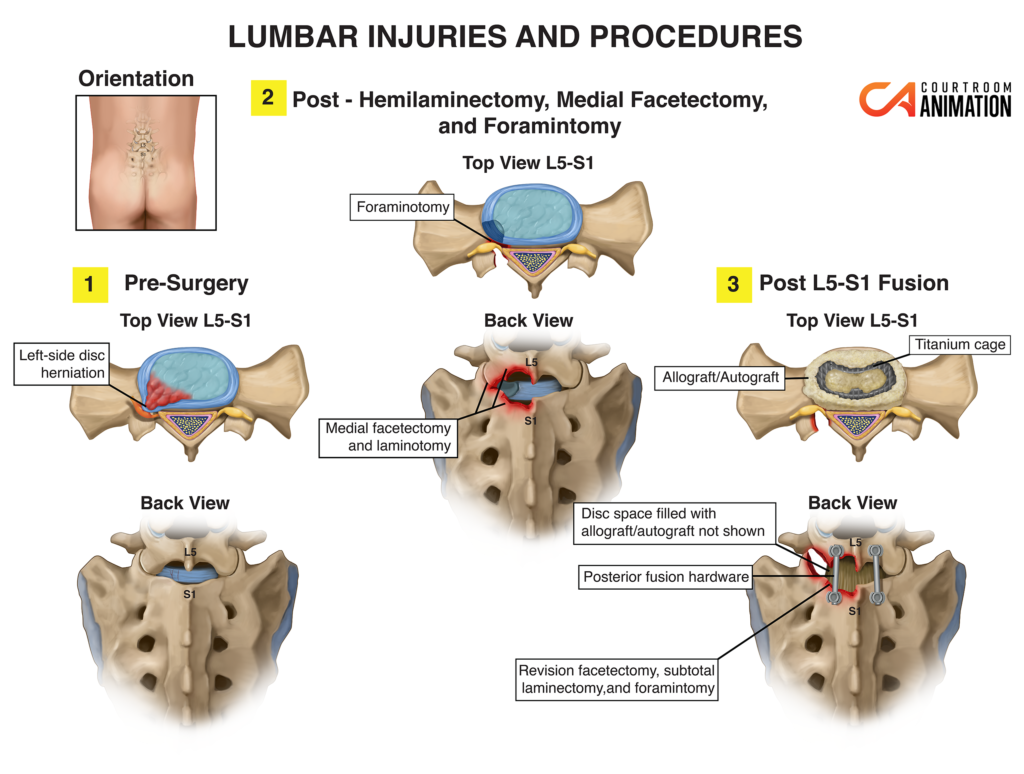Summary:
In this case, the plaintiff’s vehicle had been rear-ended, which caused severe lower back and left leg pain. After one corrective surgery, the pain lingered, so his doctors requested a different procedure, however, it was denied by the plaintiff’s insurance company.
Only after a year of living with unnecessary and severe pain did the insurance company approve the surgery. Once performed, the plaintiff’s pain subsided. The plaintiff counsel’s core argument was that the insurance company had improperly rejected the claim, and thus had acted in bad faith.
After presenting the medical animation to the jury, they delivered a $5.8M verdict!
Courtroom Animation’s forensic animators were tasked with demonstrating the plaintiff’s different pain levels, and how the two surgeries were performed. With the support of the medical graphics and the video below, the jury determined the insurance company had acted in bad faith and awarded a $5.8M verdict!
Challenge:
The plaintiff counsel had two operative reports and a medical expert to help explain the damages to the jury. The reports included complex, postoperative diagnosis statements such as, “Left-sided L5-S1 hemilaminectomy, medical facetectomy, foraminotomy with microdiscectomy.”
However, because your average juror does not have a medical degree, this incredibly technical jargon would have been difficult for the expert to explain without a visual aid.
“Courtroom Animation was easy to work with on our expedited schedule. They made sure I was happy with the product and tweaked it till it was just right. The animation was used in our closing argument. It gave the jury a lasting visual. The 2D illustration of the differences in surgery was really well received by the jury during medical testimony.”
– Robert J. Hommel, Founder of The Law Office of Robert J. Hommel
Another challenge was that the plaintiff counsel could not appropriately visualize how much pain the plaintiff was in at different time periods to the jury. If the jury could not visualize the medical procedures or pain levels, they would have difficulty understanding or remembering the attorney’s argument.
How could the plaintiff counsel visualize the preoperative pain area and levels, the two procedures, and the resulting pain of the plaintiff? The solution lay in leveraging medical illustration services and a microdiscectomy pain animation, which resulted in accurate and admissible demonstrative exhibits.
Solution: 2D and 3D Medical Illustration Services
When a case spans over several days or weeks and includes multiple operations, it’s all too easy for the jury to misremember details or not fully understand what happened. They might be distracted or inattentive as your expert testifies, causing them to miss valuable information to your core argument.
Robert Hommel avoided this by coordinating with his medical expert to use medical illustrations while they walked the jury through both procedures. The expert also confirmed that the visuals were anatomically accurate.
Instead of the plaintiff’s testimony only describing his personal experience with his left leg and foot pain for over a year, the 3D exoskeleton provided an accurate visual of the shooting pain down his tailbone, leg, and to his toes. It helped the jury understand the different levels of severe pain the client was experiencing.

But the plaintiff counsel did not only have just one animation to combat the jury’s bewilderment. The 2D medical illustration above depicted the differences between the microdiscectomy and the fusion procedures in an easy to understand manner. Grasping the distinction between them and how they affected the plaintiff was one of the major factors to the plaintiff receiving a considerably high verdict.
Results:
The trial exhibits provided a visual narrative for the jury, so that they could truly understand the journey of the plaintiff’s pain. It highlighted the plaintiff counsel’s core argument that his suffering continued as a result of the insurance company denying his claim for the second procedure.
The surgery animation and 2D medical graphics, which were delivered within twenty days, helped the jury empathize with the plaintiff’s unneeded suffering. It highlighted that the damages stopped once the fusion had been performed.
With this knowledge, the jury determined that the insurance company had been unreasonable in denying the claim, and thus was liable. The final verdict resulted in $5.8 million dollars.
Courtroom Animation’s team of visual strategists, medical animators and developers can customize your trial animation for any case involving:
- Personal injury
- Motor vehicle collisions
- Medical malpractice
- Product liability
- Birth injury
- Industrial accidents
- Construction defect
- Plane crashes
- And many other complex cases!
Get a quote for our medical illustration services and learn how we can help your case, whether in mediation or trial, today!